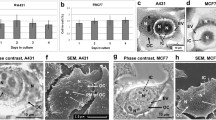Abstract
Pretreatment of embryonal chick heart fragments with ET-18-OCH3 is known to induce resistance to invasion by several malignant cell lines. Embryonal chick heart fragments or cell suspensions prepared from such fragments were explanted on solid substrate and treated in medium with 10 μg/ml ET-18-OCH3 or with drug-free medium (control) for 48 h. This medium was washed away and replaced by drug-free fresh medium. Twenty-four to 48 h later the fast plasma membrane movements (involved in ruffling, blebbing, fast shape change and fast translocation) were quantified using a simple method based on subtracting two video images taken with an interval of 28 s. The ET-18-OCH3-treated cells showed a higher intensity of fast plasma membrane movements than control cells. Cells around a treated expiant did not show the same radial alignment as in controls, suggesting loss of contact inhibition of movement. Cells from a cell suspension derived from a treated fragment showed faster translocation on solid substrate and faster shape change. We speculate that increased motility of host cells may be involved in resistance to invasion.
Similar content being viewed by others
References
Arnold B, Reuther R and Weltzien HU, 1978, Distribution and metabolism of synthetic alkylanalogs of lysophosphatidylcholine in mice.Biochim Biophys Acta,530, 47–55.
Storme GA, Berdel WE, Van Blitterswijk WJ,et al. 1985, Anti-invasive effect of racemic 1-O-octadecyl-2-O-methylglycero-3-phosphocholine on MO4 mouse fibrosarcoma cellsin vitro.Cancer Res,45, 351–7.
Storme GA, Bruyneel EA, Schallier DC,et al. 1987, Effect of lipid derivatives on invasionin vitro and on surface glycoproteins of three rodent cell types.Lipids,22, 847–50.
Bolscher JGM, Schallier DCC, Van Rooy H, Storme GA and Smets LA, 1988, Modification of cell surface carbohydrates and invasive behavior by an alkyl-lysophospholipid.Cancer Res,48, 977–82.
Bruyneel EA, Schallier DC, Bolscher JG,et al. 1989, Effects of racemic 1-O-octadecyl-2-O-methyl-glycero-3-phosphocholine (ET-18-OCH3) on invasionin vitro and on N-linked surface glycosilation. In: Kabara JJ, ed.Pharmacological Effects of Lipids III. Champaign, IL: The American Oil Chemists' Society.
Schallier DCC, Bruyneel EA, Storme GA and Mareel MM, 1991, Role of the host tissue in the anti-invasive activity of the alkyl-lysophospholipid, ET-18-OCH3,in vitro.Clin Expl Metastasis,9, 579–91.
Van Larebeke NAF, Bracke ME and Mareel MM, 1992, Invasive epithelial cells show more fast plasma membrane movements than related or parental non-invasive cells.Cytometry,13, 9–14.
Mohler JL, Partin AW, Isaacs JT and Coffey DS, 1987, Time lapse videomicroscopic identification of Dunning R-3327 adenocarcinoma and normal rat prostate cells.J Urol,137, 544–7.
Mohler JL, Partin AW, Isaacs JT and Coffey DS, 1988, Metastatic potential prediction by a visual grading system of cell motility: prospective validation in the Dunning R-3327 prostatic adenocarcinoma model.Cancer Res,48, 4312–17.
Partin AW, Isaacs JT, Treiger B and Coffey DS, 1988, Early cell motility changes associated with an increase in metastatic ability in rat prostatic cancer cells transfected with the v-Harvey-ras oncogene.Cancer Res,48, 6050–3.
Partin AW, Schoeniger JS, Mohler JL and Coffey DS, 1989, Fourier analysis of cell motility: correlation of motility with metastatic potential.Proc Natl Acad Sci USA,86, 1254–8.
Taniguchi S, Tatsuka M, Nakamatsu K,et al. 1989, High invasiveness associated with augmentation of motility in afos-transferred highly metastatic rat 3Y1 cell line.Cancer Res,49, 6738–44.
Mareel M, Kint J and Meyvisch C, 1979, Methods of study of the invasion of malignant C3H-mouse fibroblasts into embryonic chick heartin vitro.Virchows Archiv, Abteilung B: Zeil Pathologie,30, 95–111.
Van Larebeke NAF, Bracke ME and Mareel MM, 1992, Simple method for quantification of fast plasma membrane movements.Cytometry,13, 1–8.
Verschueren H and van Larebeke N, 1984, A new model for the quantitative analysis of cell movementin vitro. Definition of a shape change factor.Cytometry,5, 557–61.
Mende S, Teuscher E, Windeck I,et al. 1989, Zum Einfluss von Alkyllysophospholipiden auf Membran-potential, Teilung und Migration von isolierten Kalberaortenendothelzellen.Pharmazie,44, 713–15.
Brackenbury R, 1985, Molecular mechanisms of cell adhesion in normal and transformed cells.Cancer and Metastasis Rev,4, 41–58.
Sadoul R, Hirn M, Deagostini-Bazin H, Rougon G and Goridis C, 1983, Adult and embryonic mouse neural cell adhesion molecules have different binding properties.Nature,304, 347–9.
Rutishauser U, Watanabe M, Silver J, Troy FA and Vimr ER, 1985, Specific alteration of NCAM-mediated cell adhesion by an endoneuraminidase.J Cell Biol,101, 1842–9.
Hall AK and Rutishauser U, 1987, Visualization of neural cell adhesion molecule by electron microscopy.J Cell Biol,104, 1579–86.
Hilkens J, Ligtenberg MJL, Vos HL and Litvinov SV, 1992, Cell membrane-associated mucins and their adhesion-modulating property.Trends Biochem Sci,17, 359–63.
Meier E, Regan CM and Balazs R, 1984, Changes in the expression of a neuronal surface protein during development of cerebeller neuronesin vivo and in culture.J Neurochem,43, 1328–35.
Sunshine J, Balak K, Rutishauser U and Jacobson M, 1987, Changes in neural cell adhesion molecule (NCAM) structure during vertebrate neural development.Proc Natl Acad Sci USA,84, 5986–90.
Alessandri G, Raju KS and Gullino PM, 1986, Interaction of gangliosides with fibronectin in the mobilization of capillary endothelium.Invasion Metastasis,6, 145–65.
Schlosshauer B, Blum AS, Mendez-Otero R, Barnstable CJ and Constantine-Paton M, 1988, Developmental regulation of ganglioside antigens recognized by the JONES antibody.J Neurosci,8, 580–92.
De Cristan G, Morbidelli L, Alessandri G,et al. 1990, Synergism between gangliosides and basic fibroblastic growth factor in favouring survival, growth and motility of capillary endothelium.J Cell Physiol,144, 505–10.
Steinberg M, 1975, Adhesion-guided multicellular assembly: a commentary upon the postulates, real and imagined, of the differential adhesion hypothesis, with special attention to computer simulations of cell sorting.J Theoret Biol,55, 431–43.
Abercrombie M, 1979, Contact inhibition and malignancy.Nature,281, 259–62.
Author information
Authors and Affiliations
Rights and permissions
About this article
Cite this article
van Larebeke, N.A.F., Bruyneel, E.A. & Mareel, M.M. An anti-invasive concentration of the alkyl-lysophospholipid ET-18-OCH3 enhances the motility of embryonal chick heart cells cultured on solid substrate. Clin Exp Metast 12, 255–261 (1994). https://doi.org/10.1007/BF01753894
Received:
Accepted:
Issue Date:
DOI: https://doi.org/10.1007/BF01753894




